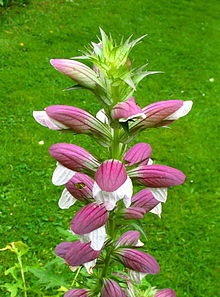Mint family
| Mint family | ||||||||||||
|---|---|---|---|---|---|---|---|---|---|---|---|---|

White dead nettle ( Lamium album ), a member of the mint family (Lamiaceae) |
||||||||||||
| Systematics | ||||||||||||
|
||||||||||||
| Scientific name | ||||||||||||
| Lamiales | ||||||||||||
| Bromhead |
The mint-like (Lamiales) are a plant order that belongs to the flowering plants (Magnoliopsida).
description
Most of them are herbaceous plants , some taxa are trees and bushes . There are also parasitic and carnivorous taxa. Most of the time the leaves are opposite, rarely they are alternate or in whorls .
The mostly hermaphrodite flowers can be four or five-fold. Usually only two or four stamens are present. Each flower usually contains two, rarely up to five carpels . Most is ovary divided by wrong septa into four chambers, each containing an ovule.
Systematics
The Lamiales are within the Euasteriden I the sister group of Solanales . The relationships from APG III were confirmed in APG IV.
The order of the mint-like (Lamiales) includes 23 families with around 1059 genera and over 23000 species:
- Acanthus family (Acanthaceae): The family is divided into four subfamilies with six tribe and 229 to 250 genera with 3500 to 4000 species, with mainly tropical distribution.
- Trumpet trees (Bignoniaceae): The family is divided into eight tribes with 82 to 104 genera and up to 860 woody species, mainly tropical, with a focus on biodiversity in South America .
- Rainbow plant family (Byblidaceae): There is only one genus:
- Rainbow plants Byblis : The six to seven species occur in Australia and New Guinea .
- Slipper family (Calceolariaceae): It contains only two genera with around 275 species, in the Neotropic and New Zealand .
- Carlemanniaceae : It contains only two genera with about five species, with a disjoint area from China to Sumatra . They are herbaceous plants or shrubs.
- Gesneriae family (Gesneriaceae): The family is divided into four sub-families with twelve tribe and 147 to 160 genera with 3200 to 3870 species, almost only tropical distribution.
- Mint family (Lamiaceae): The family is divided into seven subfamilies and 230 genera with 5000 to more than 7000 species, with worldwide distribution.
- Water hose family (Lentibulariaceae): It contains three genera with around 350 carnivorous plant species (carnivores), with worldwide distribution.
- Linderniaceae : It contains 13 genera with about 195 species, with pantropical distribution, most of the species can be found in the Neotropic . They are mostly small, herbaceous plants with zygomorphic, four-fold flowers and opposite leaves.
- Chamois horn family (Martyniaceae): It contains five genera with around 16 mostly herbaceous species in the Neotropic. They have sticky leaves that insects stick to.
- Olive family (Oleaceae): The family is divided into five tribes and 25 genera with 600 species.
- Summer root family (Orobanchaceae): It contains between 80 and about 100 genera with 1700 to 2100 parasitic , mostly herbaceous species.
- Bluebell family (Paulowniaceae): It contains only one genus:
- Sesame family (Pedaliaceae): It contains 14 genera with 62 to 85 species, with a distribution mainly in the Old World , a genus in Brazil, a focus is on the colonization of dry habitats or coasts.
- Juggler flower family (Phrymaceae): It contains about 13 genera with 188 herbaceous species, with worldwide distribution.
- Plantain family (Plantaginaceae): It is divided into twelve tribes and contains about 92 genera with about 2000 species, with worldwide distribution.
- Plocospermataceae: It is a monotypical taxon with the only genus:
-
Plocosperma Benth .: It contains only one species:
- Plocosperma buxifolia Benth. in Central America .
-
Plocosperma Benth .: It contains only one species:
- Schlegeliaceae : It contains about four genera with about 37 species in the Neotropic. They are large trees, shrubs, climbing plants or epiphytes. They have opposite leaves, zygomorphic flowers and berries.
- Figwort family (Scrophulariaceae): It contains 52 to 65 genera with around 1700 species, with worldwide distribution.
- Stilbaceae : It contains seven to eleven genera with about 39 species, with a distribution in Africa, Madagascar , the Mascarene Islands and the Arabian Peninsula , with a focus on biodiversity in the Capensis . They are mostly small shrubs, but also herbaceous species.
- Tetrachondraceae : It contains two genera with three herbaceous plant species with four-fold, radially symmetrical flowers.
- Thomandersiaceae: It contains only one genus:
- Thomandersia : It contains about six woody species in West and Central Africa.
- Iron herb plants (Verbenaceae): It contains 30 to 34 kinds with 831 to 1,200 species, with pantropischer distribution with an emphasis in the Neotropics.
A possible (simplified) cladogram (according to the Angiosperm Phylogeny Group ), which is still fraught with uncertainties, looks like this:
|
|
|
||||||||||||||||||||||||||||||||||||||||||||||||||||||||||||||||||
|
|
| ••• |
|
|||||||||||||||||||||||||||||||||||||||||||||||||||||||||||||||
|
|
The Gesneriaceae seem to be paraphyletic with respect to the Calceolariaceae and the Phrymaceae with respect to the Orobanchaceae and the Paulowniaceae.
Web links
- The order of Lamiales in APWebsite (Engl.)
- A list of all families and genera of order (Engl.)
Individual evidence
- ^ Andreas Bresinsky , Christian Körner , Joachim W. Kadereit , Gunther Neuhaus , Uwe Sonnewald : Textbook of Botany . Founded by Eduard Strasburger . 36th edition. Spektrum Akademischer Verlag, Heidelberg 2008, ISBN 978-3-8274-1455-7 , p. 906 .
- ↑ a b Angiosperm Phylogeny Group : An update of the Angiosperm Phylogeny Group classification for the orders and families of flowering plants: APG III. In: Botanical Journal of the Linnean Society. Volume 161, No. 2, 2009, pp. 105-121, DOI: 10.1111 / j.1095-8339.2009.00996.x .
- ↑ a b Angiosperm Phylogeny Group: An update of the Angiosperm Phylogeny Group classification for the orders and families of flowering plants: APG IV . In: Botanical Journal of the Linnean Society . tape 181 , no. 1 , 2016, p. 1-20 , doi : 10.1111 / boj.12385 ( abstract ).
